| Listing 1 - 10 of 25 | << page >> |
Sort by
|
Periodical
ISSN: 14653354 02634937 Year: 1982 Publisher: [Abingdon, Oxfordshire] : Carfax International Publishers
Abstract | Keywords | Export | Availability | Bookmark
 Loading...
Loading...Choose an application
- Reference Manager
- EndNote
- RefWorks (Direct export to RefWorks)
Asia, Central --- Asie centrale --- Asia, Central. --- Central Asia --- Soviet Central Asia --- Tūrān --- Turkestan --- West Turkestan --- Asia --- Central Asia.
Book
ISBN: 2722604310 Year: 2016 Publisher: Paris : Collège de France,
Abstract | Keywords | Export | Availability | Bookmark
 Loading...
Loading...Choose an application
- Reference Manager
- EndNote
- RefWorks (Direct export to RefWorks)
Понятие «Центральная Азия» – позднейшее изобретение: лишь в 1825 году оно пришло на смену термину «Татария», часто ассоциировавшемуся с монгольским террором. В XX-м веке было два археологических течения, которые внесли большой вклад в обновление исследований данного региона: французская школа, представленная национальной археологической Делегацией в Афганистане, и советская школа с ее крупными междисциплинарными экспедициями. Тот факт, что вновь были открыты два коренных языка, согдийский и б...
History & Archaeology --- Archaeology --- археоло́гия --- исто́рия --- культура --- Центральная Азия --- archéologie --- histoire --- linguistique --- recherche --- Asie centrale
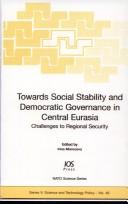
ISBN: 6610504954 1280504951 9786610504954 1607501317 1429402482 6000005903 1601291124 9781429402484 9781601291127 9781607501312 9781280504952 1586035452 9781586035457 9786000005900 Year: 2005 Volume: v. 49 Publisher: Amsterdam Fairfax, VA IOS Press
Abstract | Keywords | Export | Availability | Bookmark
 Loading...
Loading...Choose an application
- Reference Manager
- EndNote
- RefWorks (Direct export to RefWorks)
Provides the contributors' views on the socio-political challenges confronting the nine Central Eurasian states. This book presents scientific discussions on the historical development of Central Eurasia and its sociocultural legacies; Soviet and contemporary state organisation, social transformation and communal structures; and more.
Asia, Central - Social conditions - 1991-. --- Social Conditions --- Sociology & Social History --- Social Sciences --- Eurasia --- Asia, Central --- Eurasie --- Asie centrale --- Politics and government --- Congresses --- Congresses. --- Politique et gouvernement --- Congrès --- Social conditions --- Economic conditions
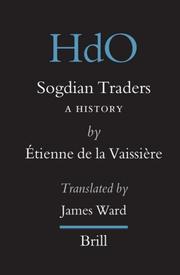
ISBN: 9004142525 9786610907007 1429452749 9047406990 1280907002 1433705230 9781429452748 9781433705236 9789004142527 Year: 2005 Volume: 10 Publisher: Leiden Boston Brill
Abstract | Keywords | Export | Availability | Bookmark
 Loading...
Loading...Choose an application
- Reference Manager
- EndNote
- RefWorks (Direct export to RefWorks)
The Sogdian Traders were the main go-between of Central Asia from the fifth to the eighth century. From their towns of Samarkand, Bukhara, or Tashkent, their diaspora is attested by texts, inscriptions or archaeology in all the major countries of Asia (India, China, Iran, Turkish Steppe, but also Byzantium). This survey for the first time brings together all the data on their trade, from the beginning, a small-scale trade in the first century BC up to its end in the tenth century. It should interest all the specialists of Ancient and Medieval Asia (including specialists of Sinology, Islamic Studies, Iranology, Turkology and Indology) but also specialists of Medieval Economic History.
Sogdians --- Merchants --- Sogdiens --- Commerçants --- Commerce. --- History. --- Commerce --- Histoire --- Silk Road. --- Asia, Central --- Route de la soie --- Asie centrale --- Businesspeople --- Sogdy --- Ethnology --- Silk Route --- Central Asia --- Soviet Central Asia --- Tūrān --- Turkestan --- West Turkestan --- Asia
Book
ISBN: 2356681760 2356680675 9782356680679 Year: 2020 Publisher: Lyon MOM éditions
Abstract | Keywords | Export | Availability | Bookmark
 Loading...
Loading...Choose an application
- Reference Manager
- EndNote
- RefWorks (Direct export to RefWorks)
"C'est au Ier millénaire av. J.-C. que le dromadaire et, plus marginalement, le chameau commencent à imposer leurs hautes silhouettes sur les routes du Proche-Orient et d'Égypte. Réunis lors de deux ateliers, à Lyon puis à Nanterre, seize archéologues et historiens ont tenté de prendre la mesure de cette révolution chamelière. Du Xinjiang au désert Libyque, l'usage de plus en plus intensif des grands camélidés de l'ancien monde est en effet venu bouleverser les domaines du transport caravanier mais aussi l'agriculture, redessinant les routes commerciales, accroissant les capacités d'exportation des oasis, désenclavant des régions autrefois isolées. Devenus progressivement une pièce majeure des systèmes économiques des régions désertiques ou semi-désertiques, les camélidés demeurent en même temps associés à des populations nomades disposant d'un savoir-faire sans lequel l'élevage et le dressage de ces grands animaux se réve lent impossibles à réaliser. Les sources écrites (akkadiennes, bibliques, démotiques, grecques...) mais aussi l'archéozoologie, l'iconographie, sans oublier l'ethnologie et la zootechnologie, sont convoquées pour traiter cette révolution chamelière dans ses multiples aspects. Ce livre présente un très grand nombre de documents, dont des inédits, et aborde un large éventail de thématiques): les différents usages des camélidés, le lien entre ces animaux et les populations nomades et sédentaires, leur place au sein des imaginaires des peuples d'Asie et d'Égypte, mais aussi dans la vie quotidienne des Grecs, Romains, Nabatéens, Arabes, habitants du Levant byzantin, populations d'Asie centrale); au sein d'environnements aussi variés que la Mésopotamie, l'Assyrie, la péninsule Arabique, le Levant, l'Égypte et l'Asie centrale. Deux articles sur le devenir récent de l'animal et sur les pratiques actuelles de l'élevage camelin en Mongolie compl ètent ce tour d'horizon sur un animal décidément central dans l'histoire des régions envisagées."--Page 4 de la couverture
Camelidae - Asia --- Camelidae - Africa --- Camels --- Camels in art --- Breeding --- History --- Archaeology --- chameau --- dromadaire --- archéologie --- épigraphie --- papyrologie --- iconographie --- Égypte --- Proche-Orient --- péninsule Arabique --- Asie centrale --- camel --- dromedary --- archaeology --- epigraphy --- papirology --- iconography --- Egypt --- Middle East --- Arabian Peninsula --- Central Asia --- Camelidae
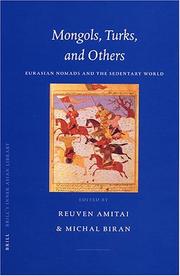
ISBN: 9004140964 9789004140967 9786610867141 1429427396 9047406338 1280867140 1433705168 Year: 2005 Volume: 11 Publisher: Leiden Brill
Abstract | Keywords | Export | Availability | Bookmark
 Loading...
Loading...Choose an application
- Reference Manager
- EndNote
- RefWorks (Direct export to RefWorks)
The interaction between Eurasian pastoral nomads and the surrounding sedentary societies is a major theme in world history. This volume explores the mulitfarious nature of nomadic society and its relations with China, Russia and the Middle East from antiquity into the contemporary world with emphasis on the Mongol and Turkish peoples.
Mongols --- Turkic peoples --- 939.6 --- S23/0500 --- S32/0500 --- History. --- Geschiedenis van Centraal-Azië: Hyrcania; Bactriana; Ariana --- Mongolia and the Mongols (including Tannu Tuva, Buriats)--History: general and before 1911 --- Central Asia--History (incl. Huns, Turkish people etc.) --- Eurasia --- Asia --- Europe --- 939.6 Geschiedenis van Centraal-Azië: Hyrcania; Bactriana; Ariana --- History --- Peuples turcs --- Eurasie --- Pasteurs --- Nomades --- Histoire --- Asie centrale
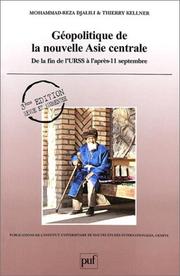
ISBN: 2130532861 2940549168 9782130532866 Year: 2006 Publisher: Paris : Presses universitaires de France,
Abstract | Keywords | Export | Availability | Bookmark
 Loading...
Loading...Choose an application
- Reference Manager
- EndNote
- RefWorks (Direct export to RefWorks)
Avec l'effondrement de l'Union soviétique et l'accession à l'indépendance des cinq républiques situées dans la région, l'Asie centrale a réintégré la scène internationale en tant que catégorie spatiale autonome. Le retour de ce que Mackinder avait naguère baptisé « le pivot géographique de l'histoire » constitue sans doute un des événements majeurs de la vie internationale de la dernière décennie du vingtième siècle. Ce fait a entraîné une transformation géopolitique dont l'importance dépasse largement les limites territoriales des ex-républiques soviétiques. Que ce soit par rapport au Moyen-Orient, au continent asiatique, à l'Eurasie et bien entendu à la Russie elle-même, de nouvelles dynamiques sont apparues dont les conséquences deviendront de plus en plus perceptibles à mesure qu'on avancera dans le nouveau siècle. La première édition de Géopolitique de la nouvelle Asie centrale est parue en mars 2001. Quelques mois plus tard, alors qu'une deuxième édition était sous presse, les attentats du 11 septembre ont eu lieu à New York et Washington. L'intervention américaine en Afghanistan et la chute du régime des talibans ont profondément modifié la donne géopolitique en Asie centrale. En quelques semaines, cette région, qui jusqu'alors suscitait surtout la convoitise pour ses ressources en hydrocarbures, est devenue le premier front de la lutte antiterroriste lancée par les États-Unis. Les auteurs de cet ouvrage ne pouvaient évidemment faire l'impasse sur ces bouleversements.
Geopolitics --- Géopolitique --- Asia, Central --- Asie centrale --- Foreign relations --- Politics and government --- Relations extérieures --- Politique et gouvernement --- Regions & Countries - Europe --- History & Archaeology --- Russia & Former Soviet Republics --- Géopolitique --- Relations extérieures --- Foreign relations. --- Geopolitics - Asia, Central --- Asia, Central - Politics and government - 1991 --- -Asia, Central - Foreign relations --- relations internationales --- terrorisme --- conflits sécurité et consolidation de la paix --- géopolitique
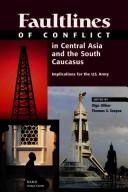
ISBN: 0833032607 9786612451201 0833048341 1282451200 1598751190 9780833048349 9781282451209 9781598751192 9780833032607 Year: 2003 Publisher: Santa Monica, CA RAND
Abstract | Keywords | Export | Availability | Bookmark
 Loading...
Loading...Choose an application
- Reference Manager
- EndNote
- RefWorks (Direct export to RefWorks)
In this volume, the authors identify and evaluate key faultlines in Central Asia and the South Caucasus and how they affect the likelihood and possible evolution of armed conflict in these regions. The analysis examines the ways in which the emergence of conflict could draw the US into the strife.
United States. --- Foreign service --- Asia, Central --- Caucasus --- United States --- Asie centrale --- Caucase --- Etats-Unis --- Strategic aspects --- Military policy --- Aspect stratégique --- Politique militaire --- Caucasia --- Caucasus Mountains --- Caucasus Region --- Kavkaz --- Soviet Central Asia --- Tūrān --- Turkestan --- West Turkestan --- National security --- U.S. Army --- US Army --- Central Asia --- Asia --- Strategic aspects. --- Military policy.
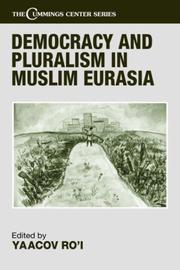
ISBN: 0714652253 0203009266 9780203009260 9780714652252 1135775761 1280059575 9781135775711 9781135775759 9781135775766 9781138967359 1135775753 Year: 2004 Volume: 19 Publisher: New York : Frank Cass,
Abstract | Keywords | Export | Availability | Bookmark
 Loading...
Loading...Choose an application
- Reference Manager
- EndNote
- RefWorks (Direct export to RefWorks)
This book is devoted to the study and analysis of the prospects for democracy among the Muslim ethnicities of the Commonwealth of Independent States (CIS), both those that have acquired full independence and those remaining within the Russian Federation. The nineteen Western academics and scholars from the Muslim countries and regions of the CIS who contribute to this volume view the establishment of democratic institutions in this region in the context of a wide and complex range of influences, above all the Russian/Soviet political legacy; native ethnic political culture and tradition; the I
Democracy --- Muslims --- Post-communism --- Démocratie --- Musulmans --- Postcommunisme --- Asia, Central --- Caucasus, Northern (Russia) --- Asie centrale --- Ciscaucasie (Russie) --- Ethnic relations --- Ethnic relations. --- Relations interethniques --- Self-government --- Political science --- Equality --- Representative government and representation --- Republics --- Postcommunism --- World politics --- Communism --- Mohammedans --- Moors (People) --- Moslems --- Muhammadans --- Musalmans --- Mussalmans --- Mussulmans --- Mussulmen --- Religious adherents --- Islam
Book
ISBN: 1487545622 1487545614 Year: 2023 Publisher: Toronto, Ontario : University of Toronto Press,
Abstract | Keywords | Export | Availability | Bookmark
 Loading...
Loading...Choose an application
- Reference Manager
- EndNote
- RefWorks (Direct export to RefWorks)
"A Woman’s Empire explores a new dimension of Russian imperialism: women actively engaged in the process of late imperial expansion. The book investigates how women writers, travellers, and scientists who journeyed to and beyond Central Asia participated in Russia’s “civilizing” and colonizing mission, utilizing newly found educational opportunities while navigating powerful discourses of femininity as well as male-dominated science. Katya Hokanson shows how these Russian women resisted domestic roles in a variety of ways. The women writers include a governor general’s wife, a fiction writer who lived in Turkestan, and a famous Theosophist, among others. They make clear the perspectives of the ruling class and outline the special role of women as describers and recorders of information about local women, and as builders of “civilized” colonial Russian society with its attendant performances and social events. Although the bulk of their writings, drawings, and photography is primarily noteworthy for its cultural and historical value, A Woman’s Empire demonstrates how they also add dimension and detail to the story of Russian imperial expansion and illuminates how women encountered, imagined, and depicted Russia’s imperial Other during this period."--
Imperialisme et sciences --- Russes --- Femmes --- Imperialism and science --- Russians --- Women --- Histoire --- Voyages --- History --- Travel --- 1800-1999 --- Russia. --- Central Asia. --- Asie centrale --- Russie --- Asia, Central --- Russia --- Colonisation --- Civilisation --- Colonization --- Territorial expansion --- Civilization --- Elena Apreleva. --- Elena Blavatskaia. --- Helena Blavatsky. --- Iuliia Golovnina. --- Russian empire. --- Russian imperial expansion. --- Russian women. --- Theosophy. --- Varvara Dukhovskaia. --- colonialism. --- travel writing. --- History.
| Listing 1 - 10 of 25 | << page >> |
Sort by
|

 Search
Search Feedback
Feedback About UniCat
About UniCat  Help
Help News
News